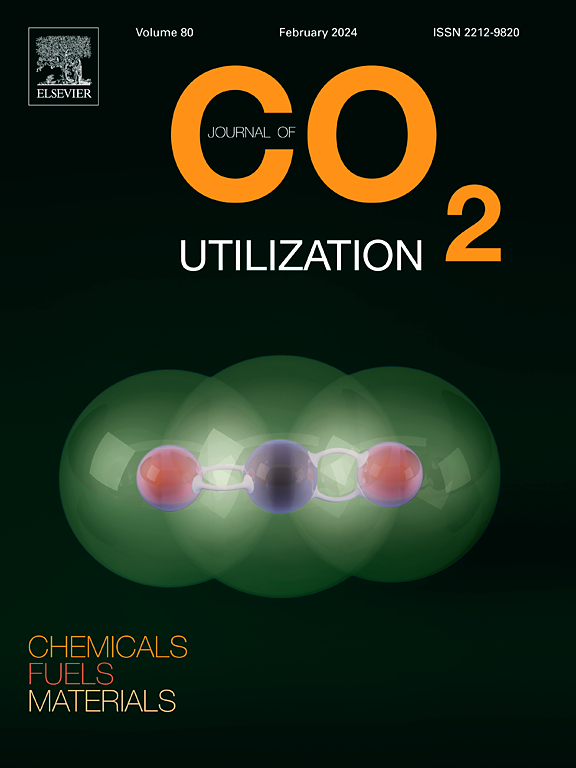绿色氧化铜光电阴极利用植物提取物的有效光电化学二氧化碳转化为醇
IF 8.4
2区 工程技术
Q1 CHEMISTRY, MULTIDISCIPLINARY
引用次数: 0
摘要
在本研究中,绿色的自制合成氧化铜纳米粒子以气体扩散电极(GDEs)的形式作为光电阴极,用于将CO2连续光电化学(PEC)转化为有价值的产品,包括甲醇和乙醇。利用鼠尾草(Salvia rosmarinus, CuO- r)、月桂草(lauurus nobilis, CuO- l)和牛耳草(Origanum vulgare, CuO- o)的植物提取物,利用这些植物中的植物化学物质形成和稳定纳米颗粒,以绿色、可持续的方式合成了CuO纳米颗粒。采用自动喷雾热解沉积技术制备了生态友好型合成cuo基光电阴极,并对其进行了物理化学、光学和光电化学综合表征,揭示了可见光照射下增强的光电流密度和良好的CO2还原为醇的产物选择性。在生态合成的光电阴极中,CuO-R表现出最高的PEC活性,对甲醇的法拉第效率超过66 %,能量效率为39.2 %,而所需的最小外部电位为- 0.37 V(相对于RHE),低于化学合成的催化剂(CuO-P)。反应后分析进一步证实,连续运行后,CuO-R保持了结构的完整性,增强了其优越的稳定性和PEC效率。这些结果表明,绿色合成途径为开发用于PEC二氧化碳减排的高性能光电阴极提供了可持续和高效的方法,为可扩展的太阳能驱动碳转换技术提供了广阔的潜力。本文章由计算机程序翻译,如有差异,请以英文原文为准。
Green copper oxide photocathodes using plant extracts for an efficient photoelectrochemical CO2 conversion to alcohols
In this study, green home-made synthesized copper oxide (CuO) nanoparticles are employed as photocathodes in the form of gas diffusion electrodes (GDEs) for the continuous photoelectrochemical (PEC) conversion of CO2 into valuable products, including methanol and ethanol. CuO nanoparticles synthesized using plant extracts from Salvia rosmarinus (CuO-R), Laurus nobilis (CuO-L), and Origanum vulgare (CuO-O) are prepared in a green, sustainable manner, leveraging the phytochemicals in these plants for nanoparticle formation and stabilization. The eco-friendly synthesized CuO-based photocathodes are then prepared by an automated spray pyrolysis deposition technique and comprehensively physico-chemically, optically, and photoelectrochemically characterized, revealing enhanced photocurrent densities and promising product selectivity for CO2 reduction to alcohols under visible light irradiation. Among the eco-synthesized photocathodes, CuO-R exhibited the highest PEC activity, achieving a Faradaic efficiency exceeding 66 % for methanol, with an energy efficiency of 39.2 %, while requiring a minimized external potential of −0.37 V (vs. RHE), lower than that for the chemically synthesized catalyst (CuO-P). Post-reaction analysis further confirmed that CuO-R maintained its structural integrity after continuous operation, reinforcing its superior stability and PEC efficiency. These results demonstrate that green synthesis pathways provide a sustainable and efficient approach to developing high-performance photocathodes for PEC CO2 reduction, offering promising potential for scalable solar-driven carbon conversion technologies.
求助全文
通过发布文献求助,成功后即可免费获取论文全文。
去求助
来源期刊

Journal of CO2 Utilization
CHEMISTRY, MULTIDISCIPLINARY-ENGINEERING, CHEMICAL
CiteScore
13.90
自引率
10.40%
发文量
406
审稿时长
2.8 months
期刊介绍:
The Journal of CO2 Utilization offers a single, multi-disciplinary, scholarly platform for the exchange of novel research in the field of CO2 re-use for scientists and engineers in chemicals, fuels and materials.
The emphasis is on the dissemination of leading-edge research from basic science to the development of new processes, technologies and applications.
The Journal of CO2 Utilization publishes original peer-reviewed research papers, reviews, and short communications, including experimental and theoretical work, and analytical models and simulations.
 求助内容:
求助内容: 应助结果提醒方式:
应助结果提醒方式:


